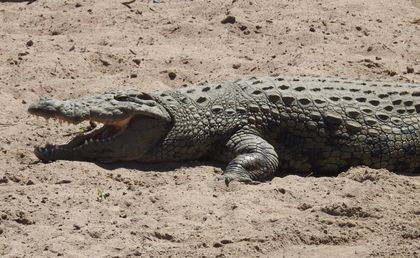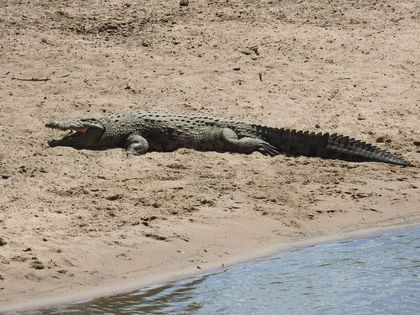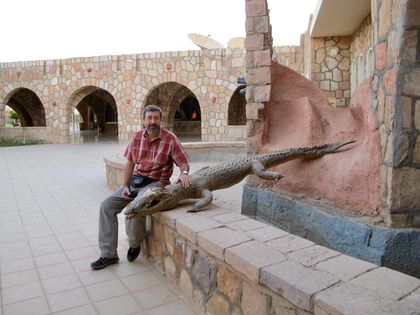Nile crocodiles in Israel
A crocodile can weigh up to 900 kg, however, its brain is no bigger than a human thumb.
05 MAY 2019 · 11:00 CET

And these are they which are unclean unto you among the creeping things that creep upon the earth; the weasel, and the mouse, and the great lizard after its kind, and the gecko, and the land-crocodile, and the lizard, and the sand-lizard, and the chameleon. Leviticus11:29-30
The Hebrew term tannin, which appears in the list of unclean animals in Leviticus 11, is translated as great lizard or crocodile in most English versions. In the book of Ezekiel, Egypt is compared to a monstrous giant crocodile (Ezekiel 29:3-4). Some scholars believe that the enormous leviathan mentioned in the Old Testament (Job 3:8; 41:1; Psalm 74:14; 104:26; Isaiah 27:1) could be an analogy for the crocodile. That said, the features of the leviathan described in the Bible do not correspond perfectly to those of the crocodile.

The men and women of the Bible were familiar with the crocodile from the Nile (Crocodylus niloticus), was common not only in Egypt, but also in Israel. In fact, we know that this huge reptile lived in Biblical lands because bone remains have been found in caves on Mount Carmel. Near Caesarea there is a stream which flows into the Mediterranean, and is known as “the crocodile stream”, or Nájal Taniním, where these reptiles could be seen right up until the start of the 20th century. The last time a crocodile was spotted in this place was 1912, and its remains are conserved in the zoological collection of a Catholic bishop, popularly known as “Father Schmitz”, just north of the Damascus Gate in the old city of Jerusalem. Thus we know that there were indeed there were Nilotic crocodiles in the Holy Land.
In ancient Egypt, they were regarded as sacred animals, capable of predicting the future of mortals, and there were even special places for their veneration in cities such as Kom Ombo, Thebes among others. The Pharaohs often had crocodiles in captivity in suitably adapted spaces in their palaces, as they were believed to be divine beings and formed part of the cast of Egypt’s mythological entities. When crocodiles died, they were mummified like the Pharaohs themselves. One of these gods, Sobek, was represented as a man with a crocodile’s head, associated with the fertility, the protection and the power of the Pharaoh.

The Nile crocodile is not exclusive to this river, as it can also be found in rivers and lakes in tropical Africa, and on the island of Madagascar. It is a sauropsida reptile, belonging to the Crocodylidae family, and can measure up to six metres long and weigh about 900 kg. Its reputation for devouring human beings is, in fact, well-deserved, as it is estimated that around 200 people are eaten by crocodiles every year. They don’t discriminate between a gazelle drinking water at the riverside and a person washing their clothes. However, their diet is usually made up of fish, zebras, nus, small hippopotami, carrion and smaller crocodiles. They can consume up to half their weight at once. Unlike other reptiles which leave their nests after laying their eggs, crocodiles and attentive and caring parents. They protect their nests fiercely and, after the eggs are hatched, they carry their new-born to the water in their mouths.
They hunt by hiding under the surface of the water, near the water’s edge, and wait patiently for animals to approach to drink. In a flash they then leap out, grab their prey and drag it into the water to drown it. They use their numerous teeth are not to chew their victim, but to hold it in their mouths. Then they turn round on their own body until they can tear off a large chunk of flesh. This behaviour is known as “the twist of death”.
In ancient Egypt, crocodiles were also associated with Seth, the god of evil. Hence, even today some people groups, such as the Nubian fishermen, place stuffed crocodiles at the entrance of their homes with the superstitious intention of warding off evil spirits.

Leviticus 11: 27-30 says: And all that walk on their paws, among the animals that go on all fours, are unclean to you. Whoever touches their carcass shall be unclean until the evening, and these are unclean to you among the swarming things that swarm on the ground: the mole rat, the mouse, the great lizard of any kind, the gecko, the monitor lizard, the lizard, the sand lizard, and the chameleon.
This text refers, among other animals, to crocodiles, and includes them in the list of unclean animals which the Israelites were forbit to eat. As we have seen, some of these animals were divinised by the surrounding cultures, so there were undoubtedly also religious reasons for this prohibition.
Nevertheless, now we know that there were important sanitary reasons behind it. At that time people could not have known why it was dangerous to eat reptile flesh. Now, however, it is known to be potentially toxic. Consuming the flesh of reptiles – such as crocodiles, lizards or snakes – can cause a range of diseases and health problems, including trichinosis,pentastomiasis, gnatostomiasis, esparganosis, among others, since they contain pathogenic bacteria, especially Salmonella, Shigella, Yersinia, Campylobacter, Clostridium and Staphylococcus.
For that reason, health authorities recommend that this type of meat be frozen before being eaten, and that it never be eaten raw, so as to avoid possible risks to one’s health. The Scriptures embody wisdom which greatly surpasses the human knowledge of the period when they were written. A crocodile can weigh, as we have seen, up to 900 kg, however, its brain is no bigger than a human thumb. Despite this, they are animals that have adapted so well to their environment that they have never been in danger of extinction.
Published in: Evangelical Focus - Zoe - Nile crocodiles in Israel
